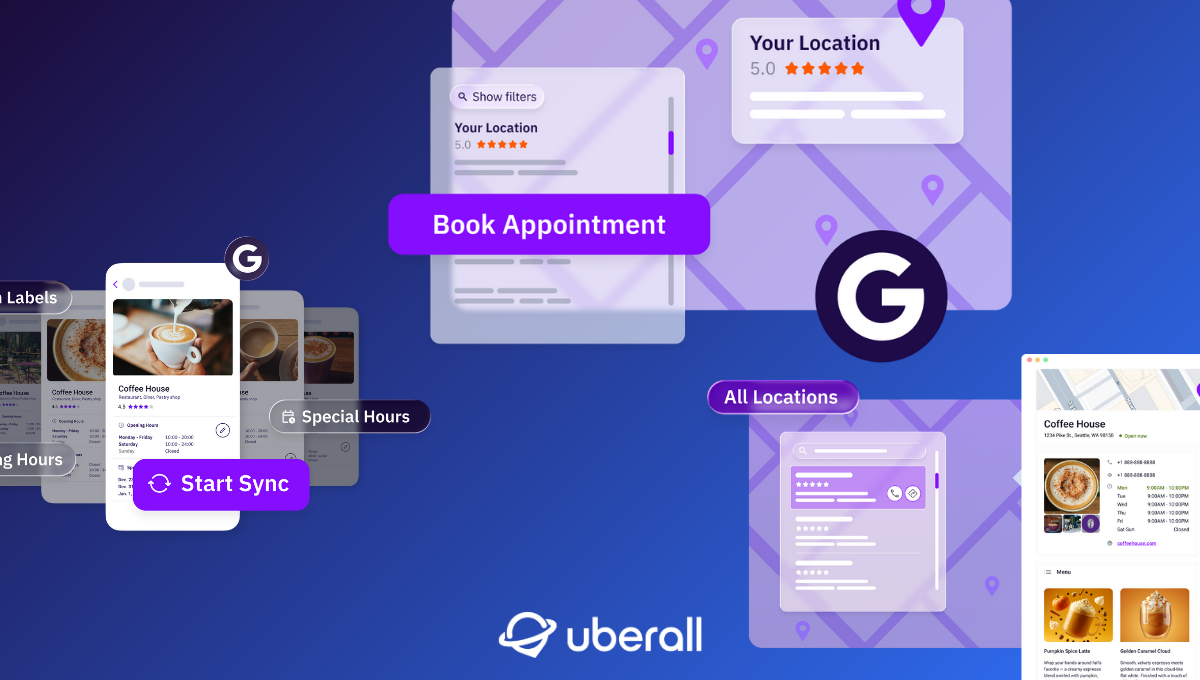
Healthcare Marketing Strategies to Heal Your Patient Acquisition and Retention
Small or nonexistent marketing team at your healthcare practice or facility? Discover what will help you stand out from your competitors.
Patients search for the right healthcare provider the same way they’d research any consumer decision — online through Google search, social media, maps, and reviews.
When we talk about businesses in this sector, we’re talking about everything from hospitals and elderly care homes to clinics, labs, imaging centres, and mental health or rehabilitation facilities.
But owning and running a medical practice smoothly is difficult — especially when there are multiple locations involved. Many smaller healthcare organizations lack dedicated marketing professionals or extensive budgets, making it almost impossible to identify key opportunities, build effective healthcare marketing strategies, and engage patients consistently across locations.
Patient acquisition and retention depend on more than excellent care. They rely on being found easily, chosen confidently, and remembered for the right reasons. To stay competitive, healthcare teams need a full-funnel marketing strategy — one that connects visibility, credibility, and patient experience across every touchpoint and every location, while maximizing ROI along the way.
1. Better Visibility Means More Potential Patients
Before any patient calls your office, fills out a form, or steps into your facility, they’ll look you up online. In fact, 91% of consumers search online before visiting a business.
And increasingly, they’ll look you up through AI search — ChatGPT, Gemini, Perplexity — not just to find a location, but to evaluate your service, reputation, and accessibility, before you evaluate their health.
So, before looking at patient retention, make sure patients can actually find and trust you online.
Google Business Profile
Our experiments with local businesses have shown that AI systems like ChatGPT consistently prioritize Google sources when generating business recommendations. But even outside of AI tools, your Google Business Profile (GBP) remains the single most important local ranking factor for healthcare discovery.
That means every profile — from urgent care centers to imaging clinics and rehabilitation facilities — must be accurate, verified, and detailed.
Include this key information:Include this key information:
- NAP: Name, address, phone number
- Business hours (including walk-in or emergency availability)
- Appointment options (in-person, virtual, or referral-based)
- Pricing
- Accepted insurance plans
- Specialties and practitioner profiles
- Accessibility features
- Patient reviews and ratings
- Photos of facilities and staff
- Posts about health awareness campaigns or new services
And as searches become more specific: “rehab center with physical therapy and weekend appointments” — providers that keep their information current, complete, and specific are most likely the ones patients choose first.
Optimize for Every Trusted Platform
But, my advice to you as an experienced search marketer: Don’t stop with Google. Healthcare consumers use a broad mix of platforms to ponder their care options, and AI models aggregate from these same data sources. That means your practice or health system needs consistent listings and profiles across:
- Apple Maps
- Bing Places
- Yelp
- Foursquare
- Industry-specific networks (insurance directories, hospital finders, and local healthcare associations)
Conflicting or incomplete data across directories can negatively impact your LLM visibility – and confuse search systems and potential patients. So really ensure your listings management is in top form, so you are the top choice, wherever people are searching
Location Landing Pages
Include localized keywords (like “orthopedic specialist in Chicago”), structured data for medical services, and landing pages for each location — even if you only have one!
Here are some examples of LocalBusiness/MedicalOrganization schema you can implement on your location landing pages:
- @type: MedicalClinic, Hospital, Dentist, Pharmacy, Optician, VeterinaryCare
- Essentials: name, image, url, telephone, address, geo, openingHoursSpecification, areaServed
- Conversions: ReserveAction, BookAction (for online booking)
- Other: FAQPage
It’s not an exhaustive list, but it should give you a few ideas to start with. Visit Schema.org for more detailed information.
Finally, your potential patients will always benefit from dedicated service landing pages when they’re scanning for specific information about your practice online. But these don’t just help patients — they help you, too.
Dedicated service pages are now a top local ranking factor. So create informative, helpful pages for each of your health services — from routine check-ups to vaccination consultations — and use clear, relevant keywords and logical internal linking between your service and location pages to maximize your visibility.
2. Superior Reputation Means Easier Patient Acquisition
Reputation is everything in healthcare. You can have the most advanced equipment and the best-trained consultants, but if your reviews are minimal, mediocre, unanswered, or inconsistent, patients will choose another provider.
That’s why healthcare organizations set such high standards. The average provider, based on our latest report, holds a 4.12-star rating, while top performers reach an impressive (and almost unbeatable) 4.89.
But it’s not just your average star rating that matters. It’s how many reviews you receive, how frequently you receive them, how many you reply to, and how quickly you respond. And here’s the thing: The top healthcare teams respond to more than 99% of their reviews — and with that as the standard, silence can quickly raise red flags for potential patients.
The average healthcare location receives 0.67 reviews per month, while top performers reach nearly four. That might not sound like a huge volume — but every single review carries weight. A single positive or negative patient story can easily influence someone’s decision about where to go for care.
Effective review management across industry-specific sites and business profiles has never been more important for healthcare providers — because it directly impacts visibility and reputation, both in search and in AI-generated recommendations.
This is especially the case as patients rely more on reviews to guide decisions about which specialists to see and where. It’s worth reiterating the obvious here: Demonstrating care, empathy, and reliability is critical in every healthcare marketing strategy.
3. Greater Engagement Means Better Customer Retention
Engagement is the part of every great healthcare marketing strategy that keeps patients connected — not just to your services, but to your mission. When you demonstrate care and expertise long before and after the first appointment, you invite stronger patient relationships and long-term retention.
Your website is your digital front door and often the first place patients visit to evaluate your credibility, expertise, and availability. It should do more than educate; it should guide and generate brand authority and reassurance. And for Your Money or Your Life (YMYL) businesses, like local healthcare providers, Google applies stricter standards to ensure accuracy and reliability.
In Google’s words: “Our systems give even more weight to content that aligns with strong E-E-A-T for topics that could significantly impact the health, financial stability, or safety of people, or the welfare or well-being of society. We call these ‘Your Money or Your Life’ topics, or YMYL for short.”
E-E-A-T signals are therefore nonnegotiable. Your content across your website and platforms must be authoritative, trustworthy, and educational — not only to attract new patients but also provide real value to people actively seeking care.
Because of this extra scrutiny, it makes sense to really invest in your local SEO and content initiatives. While this might put your practice team under pressure, the good news is that if you follow the following key recommendations, you’ll naturally increase patient engagement in the process.
- Accurate, high-quality content that answers patient questions before they even reach out
- Experience and expertise that showcases your team’s qualifications and approach
- Technical functionality so patients can quickly find the accurate information they need
- User-friendliness across all devices for patients browsing on the go
Engagement signals (or signs of vitality) — such as scroll depth, clicks, and time spent on page — are considered a local ranking factor, so creating fresh and engaging website content will ensure your practice performs well in AI and traditional search.
Social and Business Profile Posts
Beyond your website content, keep patients connected by regularly updating your Google Business Profile, Apple Business Connect profile, and socials with new services, educational posts, or community initiatives.
Healthcare providers that publish simple updates — like seasonal health tips, vaccination reminders, or local outreach initiatives — signal accessibility and care to people, and activity and relevance to search systems. In an industry where online engagement is often limited, these small actions make practices feel approachable, human, and trustworthy.
Social platforms like Facebook, Instagram, LinkedIn, and TikTok help humanize your healthcare brand, build trust, and reach new audiences through authentic, visual storytelling. You’re not only more likely to win the trust of Gen-Z patients, but you’ll also benefit from greater visibility, since the number of social mentions your business receives is a ranking factor that can help you outperform competitors.
Ideas for social content include:
- Behind-the-scenes glimpses of your care teams
- Health awareness campaigns or seasonal wellness tips
- Community partnerships and charity events
- Staff spotlights or patient success stories (with consent)
- Updates about new facilities, technologies, or programs
One last thing: Keep your messaging and tone of voice consistent across all channels — from appointment reminders to social content — to create a seamless patient journey.
4. Higher Conversion Means Better ROI
Every click, call, and direction request is a signal of high intent — and intent moves fast when it comes to healthcare decisions. Because most patients searching for care aren’t browsing casually; they’re ready to visit you. So, make it easy for them to choose you.
Start with your Google Business Profile. Make sure every location includes clear appointment and contact calls-to-action — links to your patient portal, “Book Online” buttons, telehealth integrations, and insurance details.
That’s when location-specific landing pages and URLs for each clinic or facility become critical. They should feature photos, maps, and unique service details, all links from your listings, social posts, and campaigns to create one seamless path from discovery to decision.
Patients should be able to confirm availability, understand treatment options, and book an appointment — all without leaving the page. These simple updates can increase on-the-spot conversions directly from search results. Efficient appointment scheduling is one of the most direct ways to improve patient experience and retention because you are, again, making it easy to choose you.
In the first half of 2025, our data tells us healthcare locations averaged:
- 520 direction clicks per location — showing strong demand for in-person visits to clinics, practices, and care facilities
- 531 website clicks per location — from patients checking services, insurance coverage, and appointment availability
- 334 calls per location — typically from people confirming appointments, asking about services, or checking opening hours
Top performers far exceeded these averages, with over 1,500 direction clicks, 3,200 website visits, and 2,000 calls per location. And that was really down to their commitment to seamless, consistent, and optimized digital touchpoints — across listings, websites, and apps — that made it effortless for patients to take the next step.
Your website remains the cornerstone of patient confidence. A mobile-optimized, fast-loading site with clear navigation, helpful service pages, and easy scheduling options removes hesitation and builds trust in seconds. And guess what? The load time of your pages is a local ranking factor, meaning slow pages can negatively impact how you appear in patient search results.
From Local Search to Care: Your Healthcare Marketing Strategy
Many healthcare organizations focus more on patient acquisition, but retention is where sustainable growth happens. Patients today have multiple choices, and you’ll only win their loyalty through consistently being visible, trustworthy, engaging, and easy to choose again.
When you align all of these elements in your healthcare marketing strategy, you complete the Location Performance Optimization (LPO) loop.
Each accurate listing, AI search recommendation, positive review, personalized interaction, hyperlocal post, and seamless conversion contributes to a stronger online footprint — one that helps your healthcare organization become discoverable, trusted, and chosen again and again.
Ready to Transform Your Business?
Connect with our partnership team to learn how Uberall can help you achieve similar results. Get a personalized consultation and discover the opportunities waiting for your business.
Resources

.png?width=690&height=173&name=SV%20Consumer%20Report%20Email%20(11).png)










